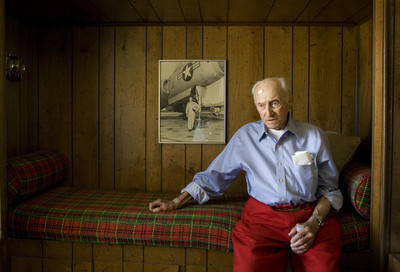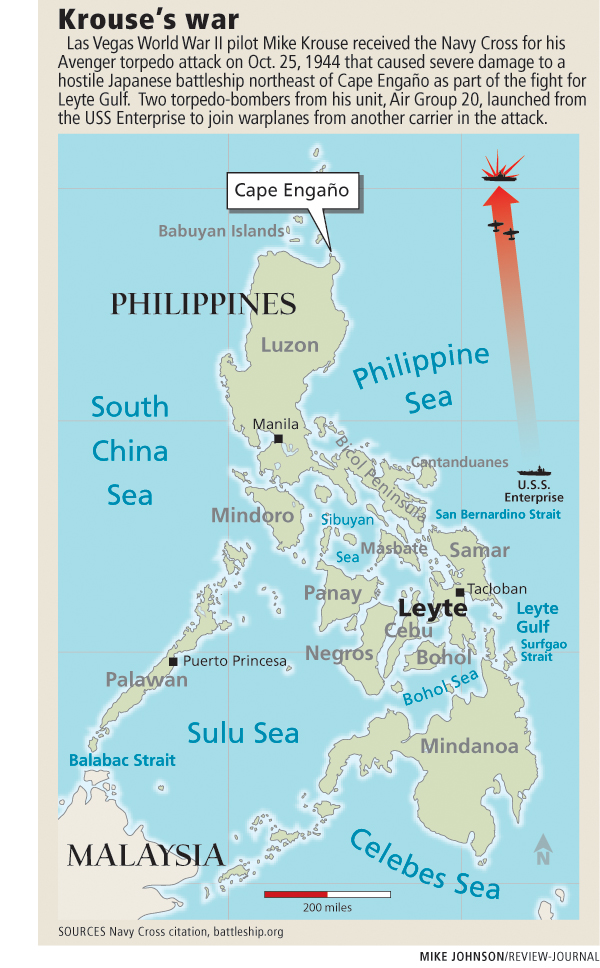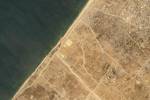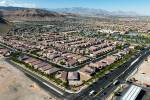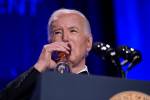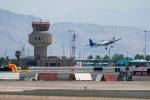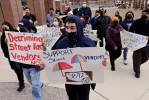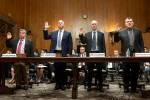Fourth of July stirs memories
For a World War II veteran whose career as a Navy pilot often sent him into the teeth of anti-aircraft fire to narrowly escape bullets and flak, one wouldn't think that a few firecrackers on the Fourth of July would bother Mike Krouse.
But in discussing the topic of what Independence Day means to him, among the things that popped into his mind was that "somebody made the wrong decision when they started firing all the firecrackers because people are getting hurt and fires are being set and people are dying," the 85-year-old Navy Cross recipient said, sitting in the office of his Las Vegas home, where he has been battling cancer.
Krouse has spent his life trying to be safe and keep people from getting hurt, especially his radioman, gunner and brothers in arms who fought the Japanese navy at Leyte Gulf in the Philippines.
His thoughts about the Fourth of July and protecting the nation's freedoms are a reflection of his service as a Navy reservist, or in his words a "street dog," who hitchhiked from Bowling Green, Ohio, to Indianapolis to join the Army as a pilot in 1942 only to be turned down.
"They said, 'Get out of our face and go back to school,'" he said in an interview last month.
The next day, after sleeping in a ditch, he hitchhiked to Detroit "and said the same thing to the Navy recruiting people. They said, 'Sign here.' I didn't even know what the hell I was signing, but I signed it. ... I went back home and very rapidly they were in touch with me."
That launched a career that would send him through flight training and land him on the USS Enterprise in Hawaii in time for the largest naval battle of World War II aboard the Navy's most decorated aircraft carrier.
The walls of his office are plastered with certificates of his medals of valor and wartime achievements. The file cabinet is filled with yellowed copies of his military papers from his days on the "Big E" in the Pacific to the 1950s when he sat in the cockpits of warplanes over Korea.
And there are records, too, from the 1960s when he worked as an assistant director for a government contractor testing nuclear weapons at the Nevada Test Site.
But Oct. 25, 1944, conjures up his most vivid memories.
An ensign at the time, he waited with his torpedo-bomber Avenger crew from Air Group 20 with his wing man, James Baxter, on the Enterprise's hangar deck.
"They finally did call us up, put us on the flight deck, launched us and told us to join up with the air group from the other carrier," he said. "So all we had to do was just tag along."
It wasn't long after he had flown north that Krouse looked down from 20,000 feet and saw a Japanese battleship.
"I said to Baxter ... 'Jesus Christ. The only thing we can do is turn around and go back out and come back in. ... You stay behind me quite a ways so that they won't see both of us coming in at a low altitude. They'll pick up on one and more less overlook the other one until it's too late.'
"So we did just that, and we flew our aircraft in and dropped our torpedoes. ... After that I threw the alcohol in the carburetor to get the hell out of there only sitting about that far above the wave tops," he said, spreading his hands a foot apart.
The strike caused "severe damage" to the ship, reads his Navy Cross citation.
"Undaunted by intense enemy anti-aircraft fire ... Krouse pressed home vigorous attacks," the citation reads. "His courage, expert airmanship and unwavering devotion to duty contributed to the success of his squadron in fulfilling this dangerous mission."
The ship, he said, "was dead in the water. It did not sink, and I was aware of the Japanese towing it back to Tokyo."
The reception when they returned to the Enterprise was "nothing special," and the tracer paths from anti-aircraft fire were only a blur, he said. "I didn't have time to worry about that."
"We were all glorious and happy about the way the invasion of Leyte Gulf was going. All our pilots were coming back from combat air patrol ... and everything was successful."
That was not the case the week before when Air Group 20 headed for Corregidor in Manila Bay to launch a strike to protect troops landing at Leyte Island.
About 40 aviators and crew were involved in the sneak attack, which he said turned sour.
"The first thing that happened is they made the biggest mistake they ever made probably right on the Enterprise," Krouse recalled.
"They sent us all in there to do the job. They knew the weather was bad. Nobody really gave the weather the consideration that it should have been given, and we headed out for Manila ... just short of the 200-mile range.
"We were climbing, turning here, turning there, doing everything to get the hell out of the weather," he said. "We went clear on the other side of the island, I don't know how many miles, and by that time I told myself, 'They're crazy, you can't do this. We're not going to have gas to get back.'"
With the rock island of Corregidor in sight, "we did our thing, dropped our bombs, made the attack and climbed out," he said. "Everybody climbed in a different direction and finally got oriented to go back home to the carriers.
"Now in order to do that it took more time to find everybody and get them back in one beehive," Krouse said.
With more bad weather on the horizon, he realized that they weren't going to reach the Enterprise in daylight.
"I knew this before anybody ever said anything about it. We're going to get back after dark," he said. "I never landed on a carrier after dark, never flew over the ocean after dark. So I'm sitting there thinking about that, and here comes the announcement. ... Anybody who wishes to ditch may ditch.
"I had two people on board, so I said to my radioman ... (Gunner Nicholas Annucci), can he swim? My man said, 'Yes.'"
"Our plan was for him to take his raft ... and stay right by the aircraft," Krouse said, explaining that the radioman would share the pilot's raft.
"We made the ditching no sweat whatsoever," he said.
But Annucci had drifted beyond the crests of the waves, causing Krouse to wonder how they were going to get him back. Somehow they managed to reach Annucci and attach the two rubber rafts.
"The next day at dawn ... the leader of the fighters on this attack came right over us and saw us and he came down real low, and he recognized me and I recognized him, and I said, 'We're going to get picked up.'"
A seaplane was sent, and Krouse and his crew were rescued.
Not all of Air Group 20's planes made it back that night. Some crashed trying to land on the Enterprise.
Twenty years later, Krouse said, he found out that his gunner, Annucci, couldn't swim.
"If I would have known that, I would have made the decision not to ditch and to go back and try to get aboard (the Enterprise), which might have even killed us all, for all I know," he said.
So for Michael Henry Krouse, the Fourth of July won't be about firecrackers. Instead it will be marked with memories about those with whom he served while defending America.
Contact reporter Keith Rogers at krogers@reviewjournal.com or 702-383-0308.
ON THE WEB Mike Krouse talks about the act of heroism which won him the Navy Cross



